
History
History & Demographics
In 1494 Christopher Columbus landed in Jamaica, while the Arawak people inhabited the island. During the 150 years of Spanish rule, the Arawak people were exterminated mainly by Columbus and his men but also wiped out by old-world diseases for which they had no cure. As a result of their extermination, African slaves were brought to the island. Then, in 1665, a British force invaded successfully. Until 1962, when it gained independence, Jamaica remained a British Colony. During the 18th century though, the slave trade expanded. Jamaican sugar production depended more and more on the slave trade as a source of cheap labor. Slavery was abolished in the 1830’s. In the years between 1839 and 1844, laborers from India were brought to replace the slaves, resulting in many becoming free. In 1865 there was an uprising, but the British governor; Edward John Eyre, repressed it so seriously that he was later dismissed from his position. Jamaica gained full self-government in 1959 through a series of amendments and constitutional developments, culminating in the National Peoples Party led by Norman Manley.
Alexander Bustamante became Jamaica’s first prime minister after the country gained independence. Later in the 1970s, Jamaica strengthened bonds with Cuba under Micheal Manley, the prime minister of Jamaica at the time. Under Manley’s “rule,” the country was teetering on the edge of economic ruin. After 1980, ties with the United States were tightened to foster mutual prosperity and to enhance regional stability and security through the Organization of American States, due to the election of Edward Seaga, who became the prime minister of Jamaica. During his term though, there were issues of overpopulation, limited resources, and unfair distribution of land and wealth.
In 1993, Percival J. Patterson became the prime minister and was reelected twice after. Despite his rule bringing political stability to Jamaica, the country was still suffering from social and economic hardships into the early 21st century. The term mestizo means mixed in Spanish and is generally used throughout Latin America to describe people of mixed ancestry with a white European and an indigenous background. This information is primarily used to describe the demographics of a county, which in this case would be Jamaica. The vast majority of Jamaicans are of Sub-Saharan African Descent with minorities of Europeans, Indians, Chinese, Middle Eastern, and others of mixed ancestry. Jamaica’s predominantly African-descendant population is a result of the slave trade practiced by the British during their colonial rule.

Charles Fort in Port Royal, Jamaica

Old view of Saint Ann Bay, Jamaica

Old church in Jamaica
Citations
“Charles Fort Port Royal Jamaica Stock Photo 1611727312 | Shutterstock.” Shutterstock, 2020, www.shutterstock.com/image-photo/charles-fort-port-royal-jamaica-1611727312. Accessed 14 Mar. 2025.
“Jamaica -- Britannica School.” Eb.com, 2025, school.eb.com/levels/middle/article/Jamaica/275127#203163-toc. Accessed 18 Feb. 2025.
“Jamaican Church Jamaica Caribbean Sea Stock Photo 1378755242 | Shutterstock.” Shutterstock, 2019, www.shutterstock.com/image-photo/jamaican-church-jamaica-caribbean-sea-1378755242. Accessed 14 Mar. 2025.
“Old View Saint Ann Bay Jamaica Stock Photo 81891541 | Shutterstock.” Shutterstock, 2025, www.shutterstock.com/image-photo/old-view-saint-ann-bay-jamaica-81891541. Accessed 14 Mar. 2025.